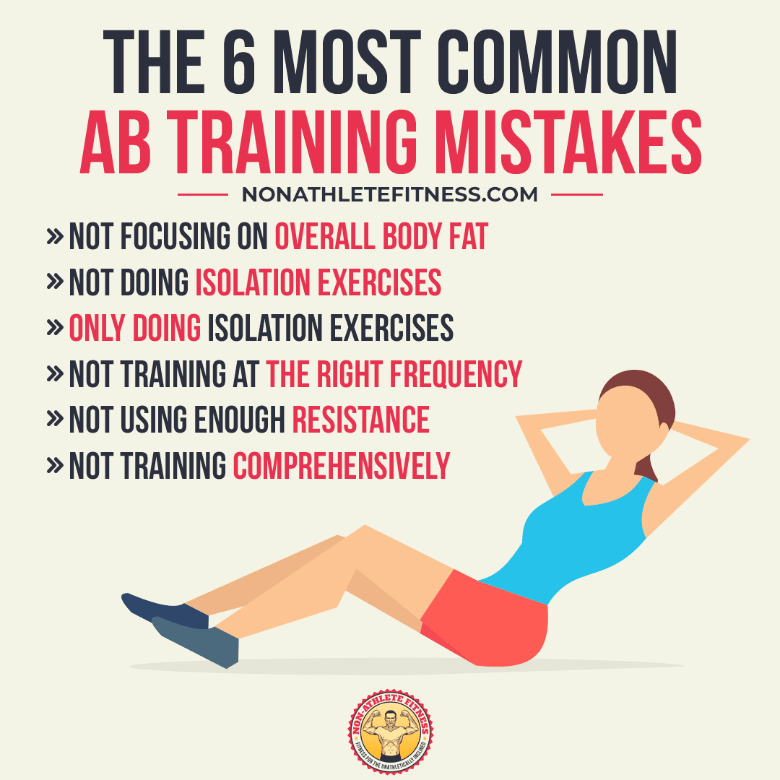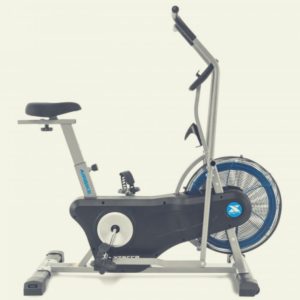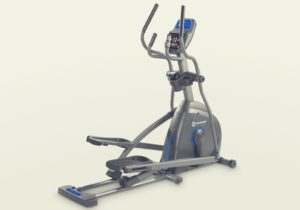You do countless ab workouts a week and still don’t see results.
You think to yourself, “What am I doing wrong?”
The answer is a few things.
While it’s true that exercising daily will help you lose weight, there’s a formula to it.
Many people make simple mistakes but still expect to see change. Today, we tell you the top six most common ab training mistakes and how to avoid them.
Not Focusing on Overall Body Fat
Most people that want to get abs start by doing tons of ab training.
While that’s helpful for a strong core and will develop ab muscles over time, it’s not necessarily the way you want to go.
Abs won’t appear if you have a layer of fat covering them.
Now, you’re probably thinking, “But how can I have a layer of fat when I work out every day?” One solution might involve your diet.
You can do all the ab training you want but you won’t see results until your body fat percentage reaches a certain percentage.
Of course, this doesn’t mean you should stop working out, it just means you might need to make some diet adjustments.
For example, binging on junk food but still working out isn’t going to get you abs.
Abs are made in the kitchen.
With a healthy diet and exercise routine, you’ll start to see results. If your diet is on track, you might want to check your exercise routine.
Many beginners often think that if they work just a certain area of the body, they’ll lose weight for that particular spot.
This practice is referred to as spot reduction. Spot reduction has been shown to not work and a myth.
However, people still try and will overtrain or do hundreds of crunches.
Unfortunately, while it makes sense logically to work out a problem area and it will eventually look the way you want, that’s not how it works.
You may strengthen your core and get stronger abs, but they won’t show up.
Ab training too much can actually have the opposite effect and make you look bloated or heavier.
This happens because your ab muscles start growing but the layer of fat they’re under isn’t decreasing.
Eat healthy with a calorie deficit and combine a full-body exercise routine to drop the fat and gain the appearance of abs.
Not Doing Isolation Exercises
The fitness world is diverse.
Typically, most people agree on what works and what doesn’t when it comes to ab training.
However, now and then you get those that have their own opinion on what to do. It may even come from top fitness experts.
One of these is isolation exercises.
Some fitness people think that you can develop abs by doing heavy compound exercises because they traditionally burn more fat.
Compound exercises use a combination of muscle groups and joints.
Exercises like squats or deadlifts certainly can help aid in your weight loss but they won’t build abs, at least not as a stand-alone.
These exercises will strengthen your core but won’t define your abs as isolation exercises will.
This is because they don’t activate the muscles as much or like isolation exercises do.
Isolation exercises target a specific joint or muscle group, but compound exercises do have benefits.
Some of these benefits include less stress on the body, more muscle development, more strength, and maximization of weight lifted.
However, there are drawbacks to compound exercises.
It’s easy to overtrain which poses a risk for injury. It also doesn’t engage certain muscles that require isolation for a better definition.
Now, you might be saying to yourself, “Didn’t you just say in the last section that I shouldn’t waste my time working on one area of my body?”
Yes! But more on that later.
You still want to work on combing both compound exercises and isolation exercises for maximum effect.
You’ll get both core strength and core definition when you combine the two.
Only Doing Isolation Exercises

There are benefits to only performing isolation exercises.
They target specific joints or muscle groups.
If you feel like a certain part of the body is weak or could use special attention, isolation exercises will do wonders.
When doing isolation exercises, it’s recommended to sit than stand for more effectiveness and to avoid having too much range of motion.
There are drawbacks to only doing isolation exercises.
They aren’t recommended for weight loss because they don’t burn as many calories as compound exercises do.
This means you’ll spend more time in the gym.
The exercises themselves take longer to do since you’re targeting one group at a time.
Your body also releases less anabolic hormones which can make the workout more strenuous.
You can do isolation only exercises but you’ll want to combine them with compound exercises for maximum benefits.
When it comes to ab training, a mix of both is recommended over choosing just compound exercises or isolation exercises.
Isolation only exercises shouldn’t be confused with spot reduction, but they do share a similar concept.
The major difference between spot reduction and isolation exercises has to do with your training routine.
Most people will only work one part of the body when trying to spot reduce (i.e. abs only for a tone stomach or glutes only for a bigger butt).
When you’re performing isolation exercises, you typically will work each part of the body (i.e. abs, arms, glutes, biceps, triceps, etc.) separately to make them stronger.
Again, practice isolation exercises but in moderation and conjunction with compound exercises.
Not Training at the Right Frequency
When people find a problem area with their body, they become determined to change it.
While their motivation is a wonderful first step, they often become too fixated on a particular area.
Ab training often suffers this fate.
People often overtrain their abs.
Many will start a routine and include ab exercises in every workout.
While for a more advanced fitness goer, it may be okay to work their abs daily.
Others just starting out or not at an advanced level shouldn’t go overboard with ab training.
Abs can theoretically be worked out daily. As each day passes, you’ll find your ab routines getting easier and easier.
While you may think you’re making great progress, you might be setting yourself back.
Like any muscle, your abs need time to rest and recover. This is especially true if you’re training your abs properly or using weight.
Abs training doesn’t need to be performed daily.
You can still achieve good results by only working them out two or three times per week. Some people forgo ab workouts or only work them out once per week!
Remember that if you want abs, don’t just focus on ab only workouts.
A total body workout with a healthy deficit diet will allow you to achieve results.
Don’t get caught up in your abs not appearing or your stomach not looking the way you want it to.
A great body takes patience and time.
Not Using Enough Resistance
Workouts are meant to make you stronger.
As you progress through each one it will become easier over time.
That’s where resistance and weights come in.
When you feel like the normal routine isn’t as challenging or you’ve been at it for a little while, you should start to make it harder.
This doesn’t mean you need to start adding weight or resistance on every workout.
Take it slow and gradually add it each week or every other.
You need to find the balance that works for you.
You don’t want your workouts to be too easy, but you also don’t want them to be near impossible or too challenging.
If you make it too hard, you run the risk of injury.
You also can slightly increase your reps as well.
Increasing your reps will add to the challenge and gradually ease you into adding resistance or weights but don’t overdo it.
Reps aren’t meant to be super high with abs.
Often, people will train their abs differently from other muscle groups.
They will favor high reps with low or no weight when it comes to abs but low reps and high weight for other muscle groups.
Low resistance on your abs will increase your endurance.
However, it won’t increase its size.
You want your abs bigger.
Once you lose your body fat, your abs won’t show if they aren’t trained properly.
If you plan to have that envied six-pack or even bigger, you want that definition to shine through.
As a guide, you can use the concept of “progressive overload” that you use for your other muscle groups. If you’re a beginner, slowly progress over time and add resistance.
Some exercises that are recommended are weighted crunches on a decline, kneeled cable crunches, and machine ab crunches.
Those that are really looking for a challenge may want to do inverted sit-ups with gravity boots.
Some will even add ankle weights to their ab training for exercises like bicycle crunches and leg raises.
Not Training Comprehensively

When people think of abs, they often think of just the six-pack area.
However, the muscle group runs far deeper than that.
The six-pack ab muscle group is called the ‘rectus abdominis.’
When you do exercises like sit-ups or crunches, that’s the muscle group you’re targeting. You may also hear people refer to this as working their upper or lower abs.
The rectus abdominis isn’t the only muscle group for abs.
There are four muscle groups in total.
It includes internal and external obliques and transverse abdominis.
Your external obliques are the largest part of your abdominal muscle group.
This muscle allows your trunk to twist.
Your external obliques work from the opposite side, so if you twist to the left, your right external oblique is activated.
Your internal obliques are located inside your hip bones.
They are also involved in twisting and turning but they control both your internal and external obliques when you twist or turn.
Your transverse abdominis is what holds your entire abdominals together.
This muscle is located underneath both the rectus abdominis and obliques. It’s important to maintain this muscle as it’s essential for a strong core.
You don’t want to just train one of the muscle groups. You want to make sure you’re hitting all the groups to get a full definition and a strong core.
To have a balanced ab development, make sure you’re training all the abdominal muscle groups.
Final Thoughts
The journey to six-pack abs can be a tough one.
You may be working out all the time and not seeing any results. You might feel as though you’re doing all the right things.
However, you may be making really common and simple mistakes.
The good news is they can easily be fixed!
Your journey to six-pack abs doesn’t have to be complicated and avoiding the above ab training mistakes will get you on the right path to your six-pack abs.




